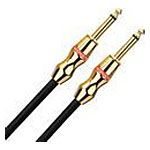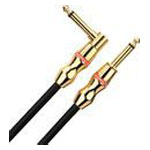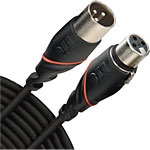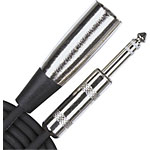Guitar Cables Guide
It doesn't take long to realize there are many different brands and types of guitar cables available.
What's the difference between them? Why spend $40 for a 10-foot cable when you can find them for $8? Why buy a TRS cable, or a cable with an XLR end? How long of a cable should you buy? What other factors should you consider?
A guitar cable is basically a wire that carries the signal from your guitar to some other device... a pre-amp, an amplifier, a pedal, a tuner... whatever. Each end of the cable has a connector, typically a phono plug. The phono plug may be straight or angled. The phono connector may carry one or two signals (TRS - Tip-Ring-Sleeve). If you have an acoustic guitar, your cable may use XLR connectors.
An ideal guitar cable would deliver the exact signal that came out of your guitar to the other end of the cable, it will lie flat, coil easily and compactly for storage, stay plugged in, and work first time, every time.
Unfortunately, we have to deal with reality, and in reality you have to decide how much you are willing to pay to minimize common problems.
Problems with Guitar Cables
- Stiff cable - A stiff cable won't lie flat and is hard to coil.
- Noisy - Hiss or other undesirable sounds enter from outside electrical sources. Shielding helps prevent this. Braided shielding works better than spiral shielding.
- Breakage - A thinner jacket allows more abuse to the shielding and core... more abuse leads to breakage.
- Unsightly - Not a problem at home or in the studio, but you may want an attractive or unobtrusive cable for use on stage.
- Poor connections - sloppy soldering (the "glue" that connects the phono or XLR end to the cable core) leads to poor signal transmission and unreliable connections.
Guitar Cable Buying Tips
Buy Shorter Cable - Never buy a guitar cable that is longer than you need. The longer the cable, the more signal loss... especially at the high end (higher notes). If you have a problem with hiss or lack of brightness, you probably need a shorter cable.
Buy Quality Connectors - no matter how good the cable, shielding and jacket is... if the connectors are poor quality, it won't transmit a clean signal. The best connectors use gold. Next best is copper. Lesser quality connectors use steel or other materials.
Buy The Right Connector - If your guitar has an XLR output, use it. Otherwise, use a phono connector. Use a TRS (Tip-Ring-Sleeve) phone connector if your guitar provides balanced output (See your instruction manual... Most are unbalanced. If it's not mentioned, assume it's unbalanced). If you need a phono connector (and the vast majority of you will) then decide if you need a straight connector or one at a 45-degree angle. Often this is a personal preference choice, but some guitars can only be used with a straight connector.
Buy a Quality Core - The core is the innermost part of the cable that actually transmits the signal from the guitar end connector to the other end. Copper is the best practical material to use for the core. In general a thicker gauge core is better than a thinner core of the same material.
Buy Quality Shielded Cable - The shield is the part of the guitar cable that wraps around the core and prevents outside electro-magnetic signals from interfering with the signal from your guitar. The shield also keeps the guitar signal trapped inside the cable to ensure that it reaches the other end. Braided shields offer better resistance to outside signals, but reduce flexibility. Spiral-wrap shielding offers a good balance of shielding and flexibility. Foil wrap shielding is the lowest cost, but also more prone to breaking and creating stiff cable.
Buy Thick/Tough Jackets - The jacket is the soft protective cover that you see. You may or may not care about its appearance, but you want a thick, durable jacket that is not too stiff.
| Highest Rated Straight Cables
For use with the vast majority of electric or acoustic electric guitars. |
 |
| Angled End To Straight End Cables
An angled plug on the guitar end reduces the chance that you'll bang it and break it as you move, but the connection on your guitar must provide enough clearance for it. Compatible with many acoustic and electric guitars. |
 |
| XLR to XLR Cable
Use XLR to XLR cable if your guitar uses an XLR output and you plan to plug into a snake, a direct-box, a speaker system or PA system with an XLR input. |
 |
| XLR to TRS Cable
Use XLR to TRS (tip-ring-sleeve) cable if your guitar uses an XLR output and you plan to plug into an amplifier, effects box, pedal, or some other device that accepts a phono plug. |
 |


